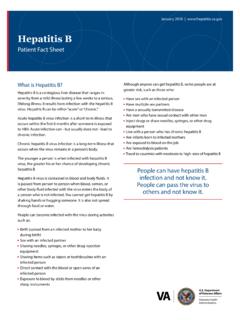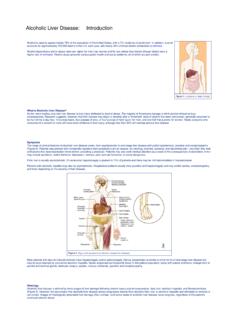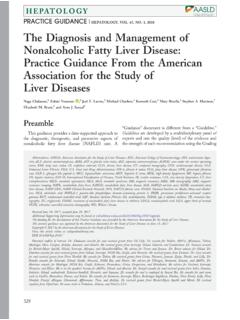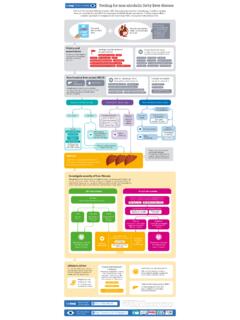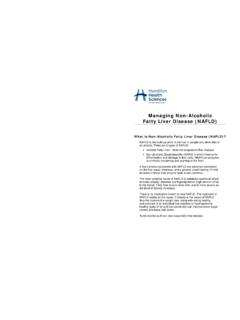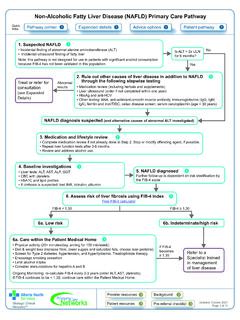Transcription of Non-Alcoholic Fatty Liver Disease: A Patient’s Guide
1 Non-Alcoholic Fatty Liver Disease: A Patient s Guide Image: National Institute of Diabetes and Digestive and Kidney Diseases, National Institutes of Health Version 2 (2019) HIV, Hepatitis, and Related Conditions Programs Veterans Health Administration Department of Veterans Affairs This document is not copyrighted, and users are encouraged to print and distribute as many copies as they need. 2 Contents To our patients .. 3 The 4 What is the Liver ? .. 4 What does the Liver do? .. 4 A sick Liver ?.. 4 Other things that can affect the Liver .. 4 Lab tests for your Liver .. 5 Names of the tests .. 5 The ALT/SGPT Test .. 5 The AST/SGOT test .. 5 The T. Bili. test .. 5 The Albumin test .. 5 The PT/INR test .. 5 Other lab tests .. 5 Non-Alcoholic Fatty Liver Disease (NAFLD) .. 6 What is NAFLD? .. 6 What happens when you have NAFLD? .. 6 Who gets NAFLD?
2 7 How do I know if I have NAFLD? .. 7 What is a Liver Biopsy? .. 7 What are the symptoms of NAFLD?.. 7 What are my risk factors for NAFLD? .. 8 Liver cancer 8 Treatment/Prevention .. 9 How is NAFLD/NASH treated? .. 9 Physical Activity (Aerobic and Resistance) .. 9 Diet changes .. 9 What diet changes can I make? .. 9 Weight loss .. 10 Medications to treat 11 Controlling diabetes .. 11 Controlling cholesterol and fats .. 11 3 Take care of your 11 Herbs to avoid .. 11 Making Smart Goals .. 12 Definitions .. 14 Resources .. 15 Contributers .. 15 To our patients Obesity is one of the leading causes of death world-wide and with this disease comes a series of medical conditions. Non- Alcoholic Fatty Liver Disease (NAFLD) is one of the diseases associated with obesity. Currently, the goal of treatment is to reduce the risk factors associated with NAFLD.
3 Awareness of this condition and lifestyle changes is key to changing the progression of the disease. Let the handbook Guide you to ask your health care provider for more information about your situation. Sometimes the information provided during a clinic visit is much more than you can absorb right away. You may forget to ask what is most important to you or you may think of a question later. We hope you will read this handbook and share it with family, friends and your other health care providers. 4 The Liver What is the Liver ? Your Liver is one of the largest organs in your body. Your Liver is located in the upper right-hand part of your abdomen and is protected by your ribs. A healthy Liver is reddish-brown in color. What does the Liver do? Your Liver works behind the scenes performing over 500 functions! The Liver acts like a factory and a filter in the following ways: Processes and stores vitamins, sugars, fats and other nutrients from the food you eat Makes substances that your body needs to stay healthy o Albumin: protein made by Liver o Bile: digestive juice which helps the body absorb fat from the gut to the bloodstream Breaks down harmful products, such as alcohol and toxins Removes some wastes from your blood Changes extra glucose (energy) into glycogen (energy storage).
4 Glycogen can be changed back to glucose when your body needs extra energy Helps with blood clotting A sick Liver ? When the Liver does not work well, you can get very sick, or even die if your Liver stops working. When the Liver does get injured, one of the earliest ways we can tell is by blood tests that show high levels of Liver enzymes in the blood, and sometimes by yellowing of the skin, known as jaundice. Other things that can affect the Liver Virus (hepatitis A, B, C, D) Alcohol Liver Cancer Obesity Prescription Drugs Street Drugs Tobacco Over-the-counter drugs A healthy Liver A sick Liver 5 Lab tests for your Liver When trying to determine the health of your Liver , your health care provider will order lab tests that can give information about whether your Liver has been damaged. Names of the tests The most common tests that are used to check how well your Liver is working are called the Liver Function Tests (LFTs) and Liver Enzymes.
5 The most common tests are: Alanine Aminotransferase (ALT/SGPT) Aspartate Aminotransferase (AST/SGOT) Total Bilirubin ( ) Albumin Prothrombin Time/ International Normalized Ratio (PT/INR) The ALT/SGPT Test This is an enzyme made in Liver cells. If the cells in the Liver are damaged, ALT enzymes are released into the bloodstream and result in higher ALT levels. ALT levels can vary and do NOT always reflect the degree of Liver cell damage nor do they assess actual function of the Liver . The AST/SGOT test This enzyme, much like ALT is made in Liver cells. High levels of AST can indicate Liver injury. However, factors not related to Liver disease can cause higher AST levels, such as other illnesses, muscle or heart injury or certain medications. The T. Bili. test Bilirubin is the yellow breakdown product of heme which is found in hemoglobin. Bilirubin is removed from the blood by the Liver , but when the Liver is not working well, bilirubin levels can rise.
6 High levels of bilirubin suggest the Liver is not working well. Signs of high levels of bilirubin include yellowing of the skin and whites of the eyes (called jaundice). The Albumin test Albumin is a protein made only in the Liver . If the amount of albumin is low, it suggests that the Liver may not be working well. The PT/INR test This test measures how well your blood clots. If the prothrombin time is high, it may mean that the Liver cannot produce enough of the clotting proteins. Other lab tests Your provider may order other tests. It is important to keep in mind that just because you may have abnormal levels of an enzyme on a test, it does not mean you Liver is failing. Also, Liver enzymes may be normal sometimes in patients who have Liver disease. Your provider will interpret these tests and work with you. Jaundice: Yellowing of the eyes and skin 6 Non-Alcoholic Fatty Liver Disease (NAFLD) What is NAFLD?
7 NAFLD is the most common cause of chronic Liver disease in the It is due to the buildup of fat in the Liver not caused by an overuse of alcohol. Fatty Liver (steatosis) occurs when the Liver has more than 5-10% of its weight in fat. NAFLD is related to obesity, diabetes and often abnormal levels of fat in the blood and high blood pressure. Fatty Liver in isolation does not damage the Liver , however nonalcoholic steatohepatitis (NASH) which is a severe form of NAFLD can cause inflammation and damage to the Liver . This can progress to scarring or fibrosis in the Liver and, in some patients, cirrhosis where hard scar tissue develops in the entire Liver . This process usually takes several years or even decades to develop. Image: National Institute of Diabetes and Digestive and Kidney Diseases, National Institutes of Health What happens when you have NAFLD?
8 Fatty Liver : Fat enters the Liver cell. Next the cell swells and changes which causes Liver injury. NASH: A bad case of Liver injury which has inflammation and swelling of Liver cells and can progress to cirrhosis or severe scarring of the Liver . Not everyone with NASH will develop cirrhosis. Cirrhosis: A scarred Liver from years of damage. 7 Who gets NAFLD? 20-30% of Americans have NAFLD 2- 5% of Americans have NASH Occurs in both males and females Adults and children (less common in children) All ethnic groups (commonest in Hispanics) Found in 80% of obese individuals, particularly those with large waist sizes Increased in individuals with type 2 diabetes Increased in individuals with high blood pressure Increase in individuals with high amount of fats called triglycerides in the blood or low levels of good cholesterol called HDL Increased in individuals with obstructive sleep apnea How do I know if I have NAFLD?
9 Routine blood tests your health care provider (increased levels of Liver enzymes) ordered may lead to testing that shows Fatty Liver disease. Fatty Liver can also be seen sometimes on X rays (ultrasounds, CT or MRI) of your abdomen where the radiologist notices fat in the Liver . Additional testing may be required to eliminate other possible causes of the high blood tests and abnormal X-rays. Some individuals who have Fatty Liver seen on X-rays may have completely normal Liver enzymes. Your health care provider may order more accurate ultrasound, computed tomography (CT) scan or magnetic resonance imaging (MRI) scans which can show a presence of fat in the Liver or Fatty Liver . A new type of ultrasound based test called elastography (Fibroscan) may be ordered to look for scarring in the Liver . The diagnosis of Fatty Liver versus NASH is often done by Liver biopsy.
10 What is a Liver Biopsy? A Liver biopsy is a simple procedure where a doctor places a needle through your skin into the Liver to get some cells. The cells are then sent to the lab to be looked at under a microscope. What are the symptoms of NAFLD? Non-Alcoholic Fatty Liver Disease can be considered a silent disease in which the person may not notice any symptoms. Symptoms may be divided in the following categories: Early Symptoms: o None 8 o Feeling tired / Fatigue o Pain in right upper abdomen Late Symptoms: o Weight loss o Fluid in the abdomen (Ascites) o Yellowing of skin (Jaundice) o Itchiness Other Symptoms: o Enlarged Liver o Obesity What are my risk factors for NAFLD? The cause of NAFLD is not completely known, however NAFLD can take years to develop. NAFLD occurs most often in people with the following: Central obesity (around your abdomen) Non-insulin dependent diabetes Insulin resistance (cells in the body do not respond to insulin) Dyslipidemia (fats found in blood which are needed for health, but sometimes become abnormal) o High triglycerides (a Fatty substance in the blood) o High LDL (bad cholesterol) o Low HDL (good cholesterol) If more than one of the above risk factors are present than you may have metabolic syndrome.



